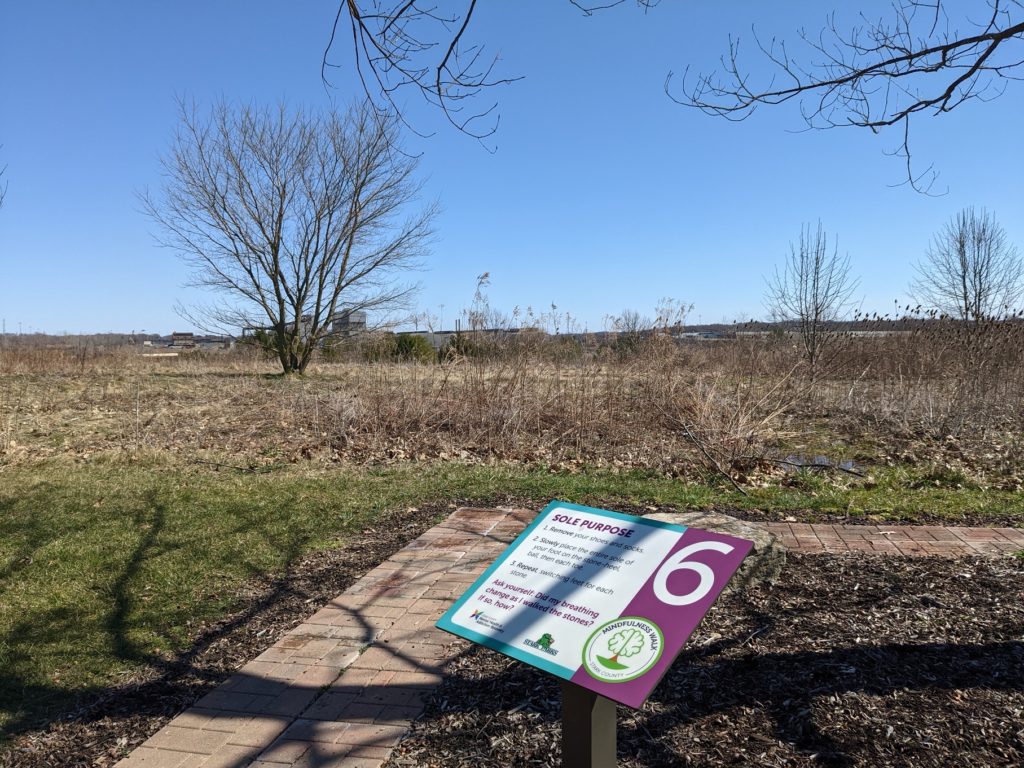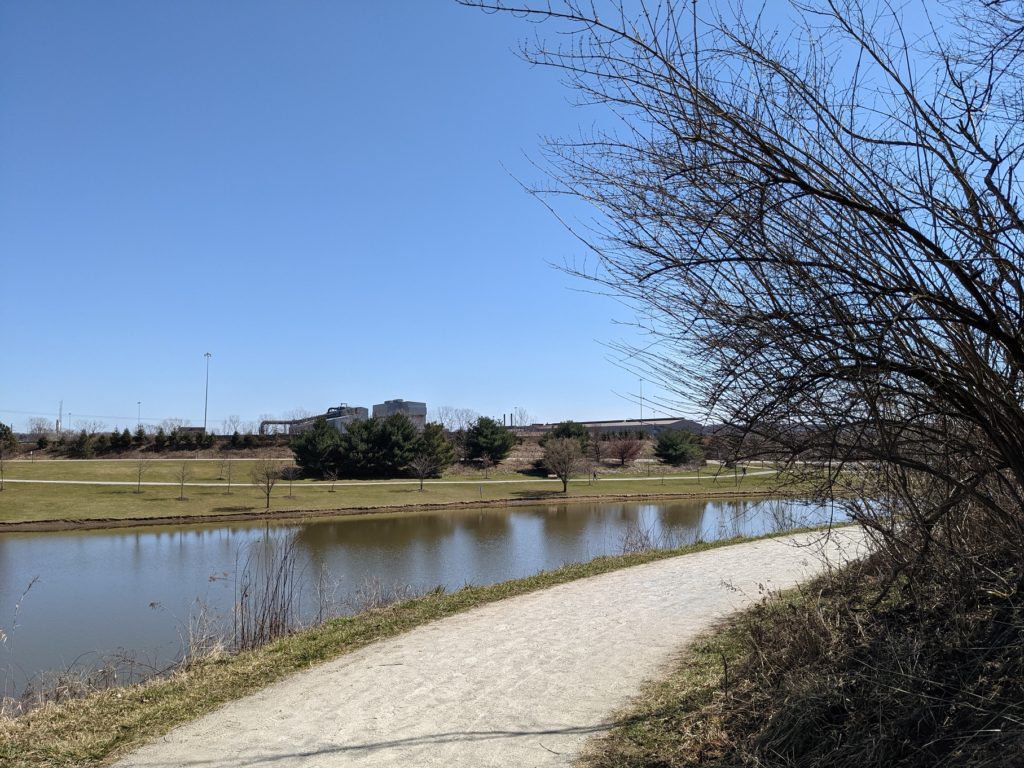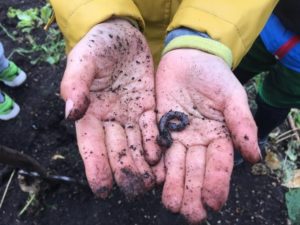Mindfulness Walk (1, 2, 3, 4, 5)
There is a park in Canton, Ohio called Petros Lake Park. I was born and grew up in the Canton area, and while visiting a couple years ago my parents told me about the park. One particularly interesting aspect of the park is that it includes a walking trail dedicated specifically to the promotion of mindfulness.
Appropriately designated a Mindfulness Walk, the one-mile trail includes ten separate stations where walkers can participate in an activity designed to help them become more mindful of themselves and their relation to their environmental surroundings. For example, there is station labeled “Seen and Unseen” that invites walkers to look and touch a nearby tree and ask themselves, “what do I have in common with this tree?” Another station labeled “Like a Rock” includes an assortment of small stones, inviting walkers to pick up the stones, feel their texture and shape, stack the stones as they see fit, and ask themselves, “To which stone do I feel most connected?”
Created in conjunction with the county behavioral health, mental health and addiction recovery board, the Mindfulness Walk offers residents a space where they can relax, reflect, become more aware of their connection with their more-than-human brethren, and practice self-care. For a county with a suicide rate that surpasses the national average and saw a 603% increase in opioid use disorders from 2004 to 2016, the award-winning Mindfulness Walk at Petros Lake Park aims to boost the mental health of residents and provide recuperative, therapeutic park space for those struggling with suicide and drug addiction.

Mindfulness Walk next to a Steel Plant (6, 7)
Directly across the street from the park and dominating the eastward horizon is a 20-acre steel factory owned and operated by the multinational corporation TimkenSteel. In fact, the existence of the park is tied to the factory, as the park’s lake was originally created to divert rainwater from the industrial facility. It is difficult to experiences the without being aware of the factory: At multiple stations, the intended activity and space is foregrounded by the enormous steel factory in the distance as it towers above the surrounding landscape.

The Need to Understand Context within Health Initiatives
The existence of a steel factory adjacent to the park does not discount the county park board’s achievement of creating a public park where local residents and visitors can enjoy stations designed to help provide a sense of calm and promote mindful reflection and relaxation. To create a park that is free for public enjoyment and that includes a walk offering opportunities for visitors to become more mindful of the relation between their bodies and trees, plants, animals, and the weather is indeed an achievement worthy of celebration.
However, the story of Petros Lake Park and its Mindfulness Walk is also reminder that we should be careful not to approach mindfulness or mindfulness practices in insolation from historical, social, economic, and political contexts. After all, the park exhibits a striking contradiction between its purpose as a space for physical and mental health and environmental awareness, and its relation to a nearby steel factory that exemplifies humanity’s ongoing destruction of the planetary ecosystem. As walkers think about their connection to trees and stones, the nearby steel plant reminds them that human society is continuing to pollute and degrade the ecosystem in the name of capital accumulation.
Walkers are asked to become more mindful of their bodies and how they are “sensing nature”, but not of humankind’s unsustainable economic activities, exemplified by the enormous steel plant across the street. Think about the inherent contradiction in trying to be more mindful of your connection to a beautiful tree that is foregrounded by a large factory actively polluting the local ecosystem that you and the tree need to live.
Mindfulness as Consumer Product (8, 9, 10)
It is not my intention to simply criticize the decisions made by its designers. Rather, we can take this opportunity to consider the following question: What does this strange juxtaposition between a dedicated park space for mindfulness practices and an environmentally-degrading steel plant suggest as to the social and historical meaning of mindfulness?
Most often, we encounter mindfulness via consumer products marketed to those seeking tools for self-improvement and self-care: Meditation podcasts to “help you manage stress, reduce anxiety, and feel more energized”; books that reduce mindfulness to a conveniently-packaged daily practice for people to “[d]issipate stress and enter the joyful stream of present-moment awareness”; seminars and workshops to workers regulate their stress levels and become more productive in the workplace. Each example presents mindfulness as a secularized, apolitical, individualized practice geared towards the optimizing of the self, be it in terms of managing stress levels, improving focus and self-awareness, or attaining better sleep so as to be more productive and active during the day. It constitutes an apolitical, acontextual understanding of mindfulness as a technology for self-regulation and self-improvement.
“McMindfulness”: A Criticism of Commodified Mindfulness (11)
The thing is, mindfulness practices are as socially constructed, contextually-shaped, and politicized as any other cultural practice and human cultural activity. For example, the scholar Ronald Purser argues that many of the predominant conceptions of mindfulness that are consumed today are forms of what he calls “McMindfulness”: Mindfulness as a commodity, a consumer product to be “sold and marketed as a vehicle for personal gain and gratification.”
Purser addresses not just the commodification of mindfulness, but how commodified forms of mindfulness conform to the principles of the contemporary capitalist system by presenting the practice of being mindful as an opportunity for individuals to optimize their health and behaviors through their consumer practices. Purser critiques this conception of mindfulness as a commodified consumer product because the practice of becoming mindful becomes as a depoliticized tool for self-improvement and self-care, severed from a social critique or a consideration of the social, historical, and systemic causes of stress, anxiety, burnout, depression, or trauma. It is also a marketed conception of mindfulness geared towards packing the practice in terms of convenience, and often problematically involves the appropriation of stereotypical Buddhist principles, images, and symbols to help give the modern mindfulness product a more “authentic essence.”
McMindfulness Walk
Through its stations, the Mindfulness Walk at Petros Lake Park in Ohio promotes a mindful practice that is similar to the forms of McMindfulness described above. The walk presents the act of becoming more aware of one’s thoughts, feelings, and relation to environmental actors as an individualized experiences, its meaning restricted to its function as a tool for self-improvement and enhanced self-awareness. None of the stations reference the large steel factory looming just beyond the park, nor do they wrestle with the environmental, human, and more-than-human consequences of such ongoing capitalist activity. Seen this way, the Mindfulness Walk misses an important opportunity to present mindfulness not just in terms of its physical and mental health benefits, but in terms of its links to social consciousness and political activism.
Context and Mindfulness
Thinking about mindfulness practices in terms of historical and social context is not to disregard its health benefits or its value as a tool for coping with stress, anxiety, and trauma. Rather, the point is that becoming mindful as an individual person and becoming more aware and critical of the historical and political forces that are fueling the epidemic levels of depression, anxiety, and burnout around the world are mutually related, not mutually exclusive.
Further, contextualizing forms of mindfulness reminds us that there are a multitude of conceptions and meanings, and that the forms of “McMindfulness” that predominate popular culture today can be contested, rethought, and changed. The practice of mindfulness does not have to be an individualized experience focused on buying consumer products to make oneself somehow more productive and less stressed all at once.
Mindfulness, as scholars like Ronald Purser argue, can also be a means of becoming more aware of the ways that contemporary historical, economic, and political forces too often perpetuate unhealthy relationships between environments, animals, plants, and ourselves. Because the meaning of mindfulness is always contextual in important ways, I can enjoy the Mindfulness Walk at Petros Lake Park in Canton, Ohio, and become more mindful of the deleterious impact of industrial activity on our planet. I don’t have to forget that the steel factory across the street.
About the Author
Samuel Clevenger holds a Ph.D. in Physical Cultural Studies and teaches Sport Management at Towson University near Baltimore, Maryland. His current research centers on the role of “idle” body practices in the construction of ecological and post-anthropocentric forms of sport and physical culture.
References
- Stark Parks. (n. d.). Petros Lake Park and Trails. https://starkparks.com/parks/petros-lake-park/
- Stark Parks. (n. d.). Mindfulness Walk. https://starkparks.com/mindfulnesswalk/
- Saker, A., & Mills, E. (2020, July 6). Suicide in Ohio: Stark among counties above U.S. average before pandemic. Retrieved December 12, 2021, from https://www.cantonrep.com/story/news/coronavirus/2020/07/06/suicide-in-ohio-stark-among-counties-above-us-average-before-pandemic/113367768/
- Stark County Mental Health and Addiction Recovery. (n. d.). Stark County’s opiate epidemic: Facts and figures. https://starkmhar.org/help/stark-countys-heroin-epidemic/heroin-facts-figures/
- Rich, D. (2020, February 13). The Mindfulness Walk wins statewide award. Stark County Mental Health and Addiction Recovery. Retrieved December 12, 2021, from https://starkmhar.org/featured-news/the-mindfulness-walk-wins-statewide-award/
- TimkenSteel. (n. d.). Our locations. http://www.timkensteel.com/buy-from-us/our-locations
- Birding in Ohio. (n. d.). Petros Lake Park. https://birding-in-ohio.com/stark-county/petros-lake-park/
- Lindberg, S. (2020, April 14). The 21 best mindfulness podcasts to listen to right now. VeryWellMind. Retrieved December 11, 2021. https://www.verywellmind.com/best-meditation-podcasts-4771686
- Mindful. (2011, December 21). Jon Kabat-Zinn releases “Mindfulness for Beginners”. Retrieved December 12, 2021. https://www.mindful.org/jon-kabat-zinn-releases-mindfulness-for-beginners/
- Mindful Way. (n. d.). Workplace mindfulness seminars and workshops. https://www.mindful-way.com/services/workplace-mindfulness-seminars-workshops/
- Purser, R. E. (2019). McMindfulness: How mindfulness became the new capitalist spirituality. Repeater Books.





